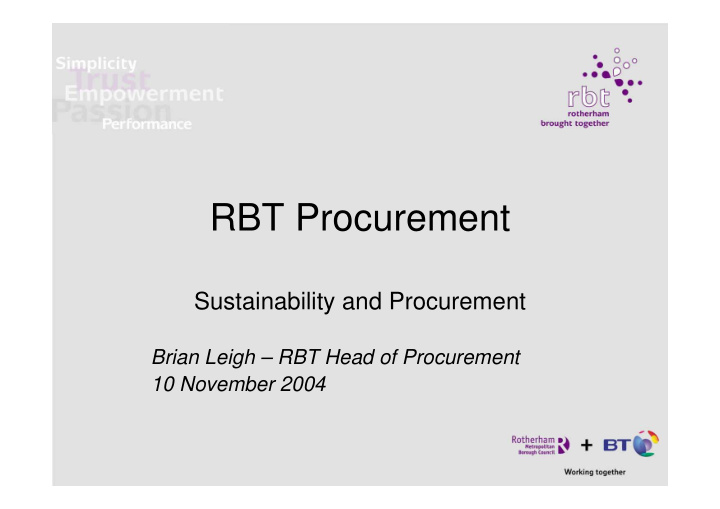



RBT Procurement Sustainability and Procurement Brian Leigh – RBT Head of Procurement 10 November 2004
Procurement In Rotherham Council • PPP/PFI • Construction • RBT – BPP Team – Best Practice (Category Management) • 9.5 FTEs looking after an £85M portfolio in 10 groups of categories e.g. Highways Materials; Water Energy and Telecomms; Office Equipment and Related Services etc. • Focus: Procurement Savings from a whole life cost (total cost of acquisition) perspective – P2P Team – Council systems (POPS/ ROCC etc.) • 42 FTEs looking after 40K orders and 150K invoices per annum • Focus: Efficient processing leading to customer satisfaction
Category Management Approach Definition: a category is a collection of commodities that can be satisfied by a single supply market Category Management Critical Strategic processes High used to move commodities around by aggregating Risk or Acquisition Leverage disaggregating Reactive Low processes used to meet day to day Council needs via Purchase Spend Low High To Pay (P2P)
Category Management Approach Supply Market Influence • One-off contracts • Strong supplier relationships • Tight fixed price contracts based on shared goals High • Main focus on continuity of • Long-term (up to 4 years) supply to RMBC contracts • Focus on stakeholder value Risk • Order/ Invoice only • No guarantee of turnover • Spot market buying • Medium-term (6 months to • 23 minutes long 3 years) framework Low agreements depending upon market conditions • Supplier chasing repeat business Spend Low High
Category Management Approach Category Strategy • RMBC Sponsor • RMBC/ RBT cross-functional team • Agreement of category plans • Identification of cost-saving opportunities: – Quick wins – More complex requirements – Obstacles • Current contracts, Audit recommendations, Risks • Agreed set of savings initiatives for next year’s Annual Plan
Category Management Approach Risk • Business Risk – Is need core to the Council’s business? – Are rework costs high? – Does the Council get good/bad PR? • Environmental risk – Is there a high energy consumption? – Are sustainable materials used by supplier? • Social risk – What are the local/ global supply chain issues? – Are there local sources of supply? • Balanced view of above enables top targets to be identified
Category Management Approach Top Targets • Aggregates • Energy • Vehicles/ Plant • Waste Management This list needs to be extended/ developed • Street lighting?
Category Management Approach Savings Initiative Implementations • Initiative Plan • RMBC/ RBT cross-functional team • Identification of Regulation/ Legislation/ Standing Orders and Financial Regulations • Market Enquiries – Informal – Formal • Supplier Selection • Mobilisation
Category Management Approach Supplier Selection • Pre-tender Questionnaire (RBT BPP) – Financial stability – Technical capability – Business Excellence including Quality Assurance standards, Environmental standards, Equality standards etc. • Specifications (RMBC Officers) – Raw Materials – Processes used • Can any current processes at the Council/ Supplier be eliminated? • Waste produced – Disposal issues • Tender evaluations (Joint RBT/RMBC)) – Standard ITTs/ RFPs – Balanced scorecard with price and quality in equity – Deeper evaluation especially on top risk targets – Supplier innovation captured
Category Management Approach Supplier Management • Supplier Reviews – Not widely used in RMBC previously – Monthly/ Quarterly – Key Measures and Improvement Targets – Management Information – Value Engineering • Waste elimination • Shortening supply chains • Built into new supplier selections from savings initiatives but we’re also trying to retrofit into existing agreements
Progress to date • Segmented 3 rd party spend (complete) • Risk analysis (on-going) • Top sustainability targets identified (part- complete) • Supplier pre-tender questionnaire (complete) • Appropriate tender evaluation (on-going) • Supplier management (on-going) • Revised procurement strategy (in progress) • Balanced scorecard of KPIs including sustainability matters e.g. % business placed with suppliers having had sustainability audit (in progress)
Beyond This Year • Building blocks in place – New Category Management processes – New systems, especially eProcurement – New holistic measures – BPP and P2P Teams in place • Biggest challenges – Batter balance of forces affecting procurement • Buy Local vs. EU Legislation vs. Procurement Savings • Environmentally friendly products vs. Buy Local vs. Procurement Savings etc. – RBT BPP Team skills – RBT P2P Team skills – Commitment from RMBC members of cross-functional teams – RMBC specifier skills
Recommend
More recommend